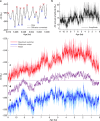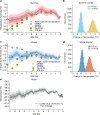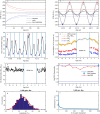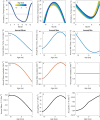Seasonal temperatures in West Antarctica during the Holocene
- PMID: 36631651
- PMCID: PMC9834049
- DOI: 10.1038/s41586-022-05411-8
Seasonal temperatures in West Antarctica during the Holocene
Abstract
The recovery of long-term climate proxy records with seasonal resolution is rare because of natural smoothing processes, discontinuities and limitations in measurement resolution. Yet insolation forcing, a primary driver of multimillennial-scale climate change, acts through seasonal variations with direct impacts on seasonal climate1. Whether the sensitivity of seasonal climate to insolation matches theoretical predictions has not been assessed over long timescales. Here, we analyse a continuous record of water-isotope ratios from the West Antarctic Ice Sheet Divide ice core to reveal summer and winter temperature changes through the last 11,000 years. Summer temperatures in West Antarctica increased through the early-to-mid-Holocene, reached a peak 4,100 years ago and then decreased to the present. Climate model simulations show that these variations primarily reflect changes in maximum summer insolation, confirming the general connection between seasonal insolation and warming and demonstrating the importance of insolation intensity rather than seasonally integrated insolation or season duration2,3. Winter temperatures varied less overall, consistent with predictions from insolation forcing, but also fluctuated in the early Holocene, probably owing to changes in meridional heat transport. The magnitudes of summer and winter temperature changes constrain the lowering of the West Antarctic Ice Sheet surface since the early Holocene to less than 162 m and probably less than 58 m, consistent with geological constraints elsewhere in West Antarctica4-7.
© 2023. The Author(s).
Conflict of interest statement
The authors declare no competing interests.
Figures











References
-
- Berger, A. Milankovitch theory and climate. Rev. Geophys.26, 624–657 (1988).
-
- WAIS Divide Project Members. Onset of deglacial warming in West Antarctica driven by local orbital forcing. Nature500, 440–444 (2013). - PubMed
-
- Huybers, P. & Denton, G. Antarctic temperature at orbital timescales controlled by local summer duration. Nat. Geosci.1, 787–792 (2008).
-
- Ackert, R. P. et al. Measurements of past ice sheet elevations in interior West Antarctica. Science286, 276–280 (1999). - PubMed
-
- Steig, E. J. et al. in The West Antarctic Ice Sheet: Behavior and Environment Vol. 77 (eds Alley, R. B. & Bindschadle, R. A.) 75–90 (American Geophysical Union, 2001).
Publication types
Grants and funding
- 0537593/US National Science Foundation
- 0537661/US National Science Foundation
- 0537930/US National Science Foundation
- 0539232/US National Science Foundation
- 1043092/US National Science Foundation
- 1043167/US National Science Foundation
- 1043518/US National Science Foundation
- 1142166/US National Science Foundation
- 1807478/US National Science Foundation
- 0230396/US National Science Foundation
- 0440817/US National Science Foundation
- 0944266/US National Science Foundation
- 0944348/US National Science Foundation

